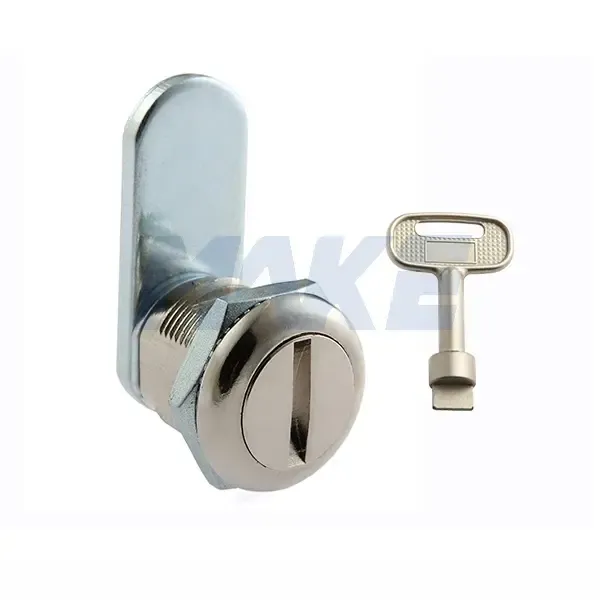In today’s fast-evolving security landscape, reliable cabinet protection has become essential across multiple industries—from retail stores and hospitals to financial institutions and industrial facilities. As organizations increasingly seek secure storage systems that can protect valuable assets, confidential documents, and sensitive materials, the demand for dependable locking solutions continues to surge. Among the many options available, cam locks have emerged as one of the most trusted, versatile, and cost-efficient mechanisms for safeguarding high-security cabinets.
Cam locks may appear simple in design, but their impact on cabinet security is substantial. These cylindrical fasteners have been widely used for decades in cabinet construction, furniture manufacturing, and commercial storage units. Their ability to blend seamlessly into the cabinet structure without altering the external appearance, combined with their strength and reliability, makes them a favorite across both residential and industrial applications.
This article takes a comprehensive look at the benefits of cam locks for high-security cabinets, explaining how they work, where they are used, and why they remain one of the most effective security enhancements available today.

A cam lock is a type of mechanical fastener composed of two primary parts: a cylindrical body and a rotating metal plate called a “cam.” The cylinder is inserted into the cabinet surface, while the cam rotates when the key is turned. This movement secures or releases the locking mechanism, depending on the orientation of the cam.
Because of their compact structure, ease of installation, and clean appearance, cam locks are widely used in cabinetmaking. They are especially popular in furniture kits and DIY cabinetry because they allow consumers to quickly assemble furniture without professional tools. Once installed, cam locks are usually hidden inside the cabinet joints, providing a seamless look that enhances the overall design.
High-security cabinets, however, often require advanced features that go far beyond basic furniture construction. Modern cam locks designed for secure storage are equipped with enhanced mechanisms that resist picking, drilling, tampering, and unauthorized key duplication. This makes them an essential component for industries where regulatory compliance and access control are critical.
Security is the primary reason cam locks are used in high-security cabinets. Over the years, manufacturers have integrated numerous technological advancements to strengthen their resilience and ensure reliable protection against unauthorized access.
One of the most common methods used by intruders to bypass mechanical locks is lock picking. High-security cam locks counter this threat with:
Complex keyways that make it difficult for lock-picking tools to navigate.
Patented key systems designed to ensure precise alignment before the lock can turn.
Anti-pick pins that disrupt attempts to manipulate internal components.
These features significantly reduce the risk of unauthorized entry, making it nearly impossible for anyone without the correct key to open the cabinet.
Drilling is another technique used by intruders attempting to break into cabinets. Many high-security cam locks are reinforced with:
Hardened steel bodies
Ball bearings placed inside the cylinder
Anti-drill plates that deflect drill bits
These elements ensure the lock can withstand aggressive drilling attempts, something particularly critical in environments where valuable or sensitive materials are stored.
Key duplication is a major concern for organizations seeking to maintain strict access control. Advanced cam lock systems resolve this issue through:
Proprietary key designs that cannot be duplicated without authorized permission
Restricted keyways that require specialized equipment for reproduction
Serial-numbered key management systems for tracking access
With these controls in place, businesses can monitor who has access and prevent unauthorized key copies from compromising security.
By combining pick resistance, drill protection, and strong key control measures, cam locks offer a comprehensive security solution suitable for any cabinet requiring robust protection.
Another significant advantage of cam locks is their remarkable versatility. They are compatible with an extensive variety of cabinet types and are widely used across numerous sectors. As industries become more reliant on secure storage, cam locks continue to prove their value in both traditional and new applications.
Retail environments are fast-paced and frequently exposed to risks such as theft and unauthorized access. Cam locks are used to secure:
Display cases containing high-value merchandise
Stockroom storage cabinets
Cash drawers and POS (point-of-sale) components
Electronics displays and kiosks
With cam locks, retailers can maintain a clean aesthetic while protecting inventory and cash-handling areas.
Medical environments require strict compliance with regulations such as HIPAA and various pharmaceutical controls. Cam locks are commonly installed in:
Medication storage cabinets
Patient records archives
Laboratory equipment compartments
Emergency supply units
Their reliable performance ensures that only authorized medical personnel have access to sensitive materials.
Banks, credit unions, and other financial facilities rely heavily on secure locking systems. Cam locks are used to secure:
Cash and coin storage drawers
File cabinets containing financial documents
Safe deposit boxes
ATM panels and service compartments
Their durability and high resistance to tampering are crucial in protecting financial assets.
In workshops and factories, cam locks serve as a protective measure for:
Tool storage cabinets
Electrical control panels
Machine access points
Hazardous material compartments
These locks withstand harsh conditions such as dust, vibration, humidity, and temperature fluctuations, ensuring long-lasting performance.
Although widely used in commercial environments, cam locks also play an important role in home security. They are often found in:
Personal safes
Home office filing cabinets
Garage tool chests
Lockable storage closets
Their ease of installation allows homeowners to secure valuable items without complex modifications.
Durability is a core strength of high-security cam locks. Compared with traditional cabinet fasteners, cam locks are specifically engineered to withstand years of heavy use and resist various environmental factors.
Most high-security cam locks are made from:
Hardened steel, offering superior resistance to physical attacks
Brass, known for its corrosion resistance
Zinc alloy, providing a balance between strength and affordability
These materials prevent rusting, deformation, and mechanical failure even in demanding settings.
Many cam locks are coated with:
Anti-corrosion layers
Powder-coated finishes
Chrome plating
These protective coatings extend lifespan and preserve the lock’s appearance, making them suitable for outdoor or semi-outdoor installations.
High-security cabinets in public or industrial spaces may be accessed frequently. Cam locks are constructed to perform reliably despite:
Constant movement
Vibrations
Temperature fluctuations
Repeated locking and unlocking
This long-lasting durability ensures consistent protection without mechanical degradation.
While high-tech locking mechanisms such as biometric scanners and electronic access systems have grown in popularity, mechanical cam locks remain widely preferred due to their user-friendly design.
To lock or unlock a cam lock, the user only needs to:
Insert the key
Rotate the cylinder
Allow the cam to engage or disengage the latch
This straightforward process reduces the likelihood of user error and allows quick access during urgent situations.
Installing a cam lock typically requires:
Basic drilling equipment
A simple mounting hole
Standard screws and tools
This makes them ideal for mass deployment in commercial settings.
Unlike electronic locks, cam locks:
Do not rely on electricity
Never need batteries
Are not affected by power outages
This ensures continuous access and security without maintenance concerns related to electrical components.
Organizations often seek high-security cabinet systems that do not exceed budget limitations. Cam locks remain one of the most cost-effective solutions available.
Compared to advanced electronic access solutions, cam locks offer:
Lower upfront cost
No operational energy expenses
Minimal maintenance requirements
This makes them an ideal choice for businesses of all sizes.
Because cam locks are:
Durable
Resistant to corrosion
Mechanically simple
They rarely require replacement or repair. This reduces lifetime ownership costs and provides exceptional value.
Organizations outfitting multiple cabinets—such as schools, hospitals, or factories—can implement cam lock systems without straining budgets. Their simplicity also reduces installation labor costs.
Cam locks have proven to be an indispensable security component for high-security cabinets across industries. Their combination of durability, user convenience, versatility, and strong protective features makes them an excellent choice for organizations seeking reliable and cost-effective storage security.
From retail stores and healthcare facilities to industrial plants and financial institutions, cam locks continue to deliver dependable protection against unauthorized access. Their advanced anti-pick and anti-drill mechanisms, proprietary key systems, and long-lasting performance ensure that important assets, documents, and equipment remain safe at all times.
As the demand for secure storage solutions grows, cam locks remain a trusted and practical option for enhancing cabinet security in both commercial and residential settings. Whether used for safeguarding sensitive materials, protecting valuable items, or maintaining regulatory compliance, cam locks offer a perfect blend of security and simplicity—reinforcing their role as one of the most versatile and effective locking mechanisms available today.
